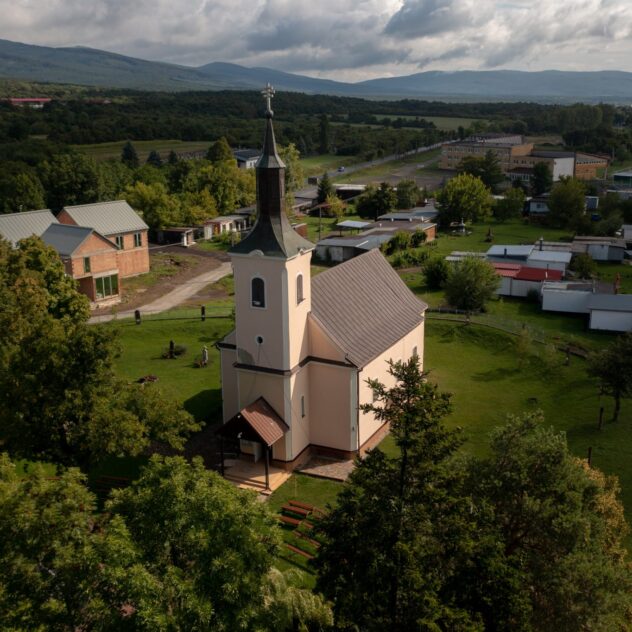Weeping icon of the Mother of God in the Church of the Assumption of the Most Holy Mother of God in Klokočov
Information about the pilgrimage site
The establishment of this most important Greek-Catholic pilgrimage site in the lower Zemplín region and the most important for the entire Košice Eparchy is connected to an event in 1670. It was a period of fighting between the Hungarian Calvinist magnates and the Catholic Habsburg army. Both sides fought each other, destroyed each other and did not spare the churches and monasteries, which burnt down several times during this period. Many valuables and documents were also burnt there.
When the inhabitants of Klokočov saw the Hungarian Calvinist army rushing into the village, the inhabitants concentrated on the icon and begged the Mother of God to avert destruction. Then the face of the Mother of God on the iconostasis darkened and began to tear up. This unusual tearing of the icon in Klokočovo was the first of a series of “miraculous tears”. Eventually, the army stormed the temple and began to cut the icons with knives and bayonets. However, when they stopped in front of the icon of the Mother of God, they saw tears welling up in her eyes. Eventually the soldiers set the temple on fire and it burned down. The icon, however, was saved. It is no longer known exactly whether the frightened soldier backed away from the icon, or whether the people present in the temple blocked his path to the icon and fled with it into the woods. This event was recorded in the “Song of the Klokočov Image”, which is the oldest folk song from 1670-1683 and is written in the Church Slavonic language.
Today, a second copy of the original icon is on display for veneration. Even today, reverence for the icon of Klokočov is still alive, as evidenced by the many pilgrimages and spiritual activities that take place here. The main pilgrimage takes place in mid-August and is linked to the feast of the Dormition of the Most Holy Mother of God, to whom the church is dedicated. Attendance at the pilgrimage site is around 30,000 faithful.
Tourist attractions in the vicinity
Zemplínska Šírava – with an area of 33 km² it is the second largest body of water in Slovakia. The nickname “Slovak Sea” was coined during the communist period in the second half of the 1970s, when Zemplínska Šírava was a popular summer holiday resort of the entire “Eastern Bloc”, when the number of visitors exceeded one million annually. The area has a large number of tropical days and nights, making it one of the warmest areas in Slovakia. In the vicinity of the reservoir there are several recreational centres offering accommodation, catering services as well as various water attractions and wellness (e.g. Thermalpark Šírava with a number of attractions). Zemplínská Šírava is also home to a large number of protected species of water birds, fish and flora.
Vyhorlatské vrchy – the Vyhorlatské vrchy Mountains are located in the Vihorlat Protected Landscape Area. Deciduous, mainly beech forests predominate. For several years now, the local Vihorlatský průže (Vihorlatský prforest) has boasted a UNESCO quality seal, which is home to many animals and plants. The vast summit ridge of Vihorlat has two peaks, the main western one and the eastern one a few metres lower. The peaks are approximately 400 metres apart. From the peaks of the mountains there is a magnificent view, with good visibility it is possible to see panoramic views and one can see into 5 countries: the territory of Slovakia, Poland, Ukraine, Hungary and Romania. The Vihorlat Mountains are one of the most forested mountain ranges in Slovakia. The Morské oko lake, which is the third largest non-crusted natural lake in Slovakia, is also popular.
Lake Vinian and castle – in the village of Vinné there is a popular natural lake, which has above-average warm water. It is surrounded by beautiful nature in the middle of dense forests under the ruins of a medieval castle. Lake Vinné was created at the end of the 19th century as a pond. In the summer season, several cultural events are organized here, and unpretentious tourists will find several accommodation options. Vinian Castle is more than 700 years old and has a rich history. Interestingly, 2,000 copper coins have been found in its vicinity, as well as a preserved vine of the Neuburg variety, which is approximately 200 years old. Today, this medieval building is a ruin, and visitors can enjoy traditional summer castle games, learn about traditional crafts and see working replicas of an ancient crane, a treadwheel and a wine cellar with wine from local winemakers.
Wooden churches – there are unique sacral buildings in Slovakia that have an extraordinary global value – wooden churches. Currently, there are about 50 wooden churches preserved in Slovakia, 8 of them are also included in the UNESCO World Heritage List. They are original in their construction technology: the building is made entirely of wood, with no metal nails used. There have been more than 300 such wooden churches in Slovakia. Interestingly, their architecture blends elements of Western culture (especially Roman) and Eastern Byzantine culture. Near Klokočov there is one of the wooden churches in the village of Ruská Bystrá – it is a UNESCO World Heritage Site and its interior is decorated with a rare unique icon of the Crucifixion. Another wooden church in the village of Inovce has been declared a National Cultural Monument.
Senianske rybníky – in the village of Senné there are ponds, which are among the most important ornithological sites in Central Europe. More and more ornithologists come to this site not only from Slovakia, but also from Europe because of the richness of bird species – so far up to 145 bird species have been recorded. Nature lovers have the opportunity to observe birds but also to enjoy sport and recreational fishing in the ponds.
More tourist attractions in the vicinity of the Klokočov pilgrimage site can be found on the website:
- Regional Tourism Organisation Dolný Zemplín (https://www.dolnyzemplin.sk/?language=EN)
- Regional Tourism Organization (https://www.kosiceregion.com/en/).
Weeping icon of the Mother of God in the Church of the Assumption of the Most Holy Mother of God in Klokočov
Accommodation
- Accommodation for pilgrims: there is currently a pilgrimage centre in the exhibition, where there will be possibilities for accommodation for pilgrims as well as facilities for holding various events with a spiritual programme.
- Other private accommodation in Klokočov or in the surrounding villages.
Availability
By car
Access by car is the fastest. The nearest larger town is Michalovce, which is a district town, and it is 14 km to Klokočov. The nearest exit from the D1 motorway is Bidovce. In general, in this area of eastern Slovakia there are mainly roads of II and III class. The pilgrimage site is located on the bank of the Zemplínska šírava reservoir, which is mainly visited for summer recreation.
By public transport
From the train station in Michalovce it is possible to use public bus transport to Klokočovo. Buses run mostly at hourly intervals, the journey takes about 20 minutes.
On foot
There is no marked hiking trail leading directly to Klokočovo. The nearest significant tourist route from the village of Hôrka goes to the village of Kaluža, from the part of Kamenec Klokočov is accessible only by the III. class road, which can be frequented.
On a bicycle
There is currently no marked cycle path leading to the Klokočov pilgrimage site. The place is accessible by bicycle only on a relatively busy road of class III.






